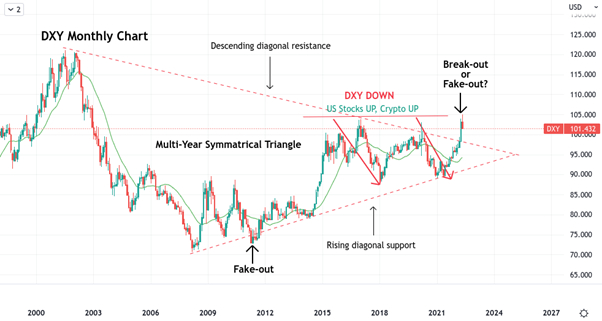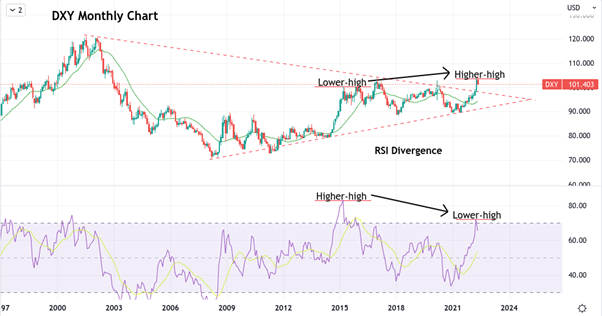The DXY has enjoyed what can only be described as a parabolic move up since last summer’s lows, where it reached just below the 90 levels. Since then, we’ve seen an ever more hawkish Fed, the raising of rates, and now we await the scheduled commencement of quantitative tightening this month.
US dollar strength has been a direct result of investors anticipating a general withdrawal of liquidity. Remember, the US dollar is a major recipient of all the risk-off activity when investors sell tech or crypto with the expectation of lower lows for the foreseeable future in these high-risk assets.
And that is exactly what has unfolded so far this year. The S&P 500 is down around 20% from its highs, and the broader crypto market is down around 60%. Naturally, with these markets so oversold, the calls for a top in the US dollar and a bottom for risk assets are getting louder. This is particularly true since investors have been overwhelmingly one-sided in their bearish risk-off bets for the first half of this year.
A Long-Term Symmetrical Triangle
As you can see below, April’s bout of dollar strength has caused the DXY to break out of a symmetrical triangle pattern that started forming in 2001. This last spike also takes out the 2016 high (the Brexit vote followed by Trump’s election) and the April 2020 peak (COVID-19), which failed to break the DXY out of the aforementioned triangle.

Symmetrical triangles differ from ascending and descending triangles in that they don’t feature any horizontal lines of support or resistance. They also don’t have a directional bias, unlike ascending triangles with a bullish bias and descending triangles with a bearish bias.
But a break-out from any triangle pattern isn’t necessarily bullish or bearish. In the case of a bull break, if any follow-through does not accompany it, the asset in question runs the risk of trailing back down to test the descending trend line as support or even dipping back below it.
As you can see above, in April 2011, the DXY broke below the rising diagonal support for a few months before reclaiming that level. It has traded within the same triangle pattern ever since.
For the recent break not to be a fake-out, the bulls would like to see the price extend away from that trendline or, failing that, a successful retest of the descending trendline before making new highs. Both of these scenarios keep the DXY in a bullish trend. On the current monthly candle, this descending line of support is currently at 97.85, which roughly coincides with the March 2015 high.
A Long-Term RSI Divergence
Within the point of the symmetrical triangle we looked at above, you can also see quite a significant RSI divergence occurring, again on the monthly timeframe, which this recent rally has failed to break. As you can see below, between 2015 and 2017, the DXY traded in a heightened risk-off range between 92 and 104 as markets attempted to digest several geopolitical events that blindsided investors: the Brexit vote and Trump’s election.
In December 2016, the monthly candle closed at 102.0 while reaching an intra-month high of 103.6. This coincided with a large monthly RSI divergence relative to the DXY’s previous 2015 high because the 103.6 peaks were achieved with an RSI just over 68, barely into overbought territory. 2015’s 100.5 peaks occurred with a highly overbought RSI of 82.8, where 70 is considered overbought. The DXY would lose almost 15% of its value between then and March of 2018.

This most recent rally has failed to put the DXY into overbought conditions as they were back in 2015. Even if the current move higher isn’t over - some investors are expecting a blow-off top - it’s hard to imagine the DXY becoming that overbought after such a run. You have to go back to 1984 for a higher RSI reading than 82.
Conclusion
DXY just broke out of a long-standing technical pattern in a bullish direction. This break coincides with a long-standing RSI divergence that usually signals the exhaustion of a move. What’s significant about these technical patterns is that they occurred in a monthly timeframe.
With the price already retracing and recent guidance from the Fed signaling a likely pause in hikes, the conditions are in place for a DXY consolidation, allowing risk assets to perform. This, however, could be a short-lived phenomenon if the DXY holds the trend. 98 is the next level to watch if 100 fails to hold.
Disclaimer: Contracts for Difference (‘CFDs’) are complex financial products traded on margin. Trading CFDs carries a high degree of risk. It is possible to lose all your capital. These products may not be suitable for everyone, and you should ensure that you understand the risks involved. Seek independent expert advice if necessary and speculate only with funds you can afford to lose. Please think carefully whether such trading suits you, considering all the relevant circumstances and your resources. We do not recommend clients post their entire account balance to meet margin requirements. Clients can minimize their level of exposure by requesting a change in leverage limit. For more information, please refer to HYCM’s Risk Disclosure.

